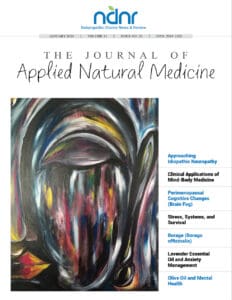Virginia Osborne, ND and Paul Anderson, ND
In this article we will cover in brief the benefits of IV chelation and nutrient therapies. We will discuss the underlying need for chelation therapies due to the toxic effects of heavy metals, which destroy the balance of biochemical pathways, leading to degeneration and disease. We will also briefly look at common IV nutrients that support normal function and balance in the cardiovascular system.
Chelation Therapy
Heavy metal buildup initiates injury to the cell structure of the vascular endothelial lining, leading to free radical formation (inactivating selenium and glutathione). This creates oxidative stress, resulting in a suppression of ATP, enzymes, decreased nitric oxide (NO) and series 3 prostaglandins. The reduction of series 3 prostaglandins in turn creates an imbalanced series 2 thromboxane to series 3 prostaglandin ratio. In the presence of free radicals generated by the metals, thromboxane-II and serotonin are released from platelets, generating arterial spasm. This combination of endothelial damage and inflammatory cytokine release creates an area of inflammatory damage and hyperactivity in the vessel wall. This begins a cycle of increased free radical activity, inflammation and propensity for heavy metals (and a few essential minerals) to build up. Ultimately, the areas of inflammatory reaction attract lipid (cholesterol) deposits, which the body solidifies with calcium in an atherosclerotic plaque (Murungi, 2004).
The NO cascade appears to be in the center of vascular and cardiocyte function (and dysfunction). In addition to the seemingly simple idea that low NO leads to hyperirritable smooth muscle (vasospasm, angina, hypertension), it is known that the NO synthase enzyme system (catalyzing the conversion of L-arginine to L-citrulline, creating NO) can be inhibited by multiple heavy metals (Mittal, 1995; Weaver, 2004). Also, this important system appears to be in the middle of a vascular dysfunction cascade involving microparticles (MPs). These MPs are small vesicles released from the membrane surface during cell division and apoptosis in normal vascular tissues. Their release attracts (via phosphatidylserine ligand reaction) additional inflammatory mediators to the injured endothelium. This causes an accelerated inflammatory response at the already injured endothelial site (Tesse, 2006).
Chelation with EDTA has a number of postulated benefits, with the removal of toxic heavy metals and movement of plasma and tissue calcium being paramount. EDTA treatment lowers ionized plasma calcium and concomitantly causes the production of parathormone (PTH). With intermittent treatments of EDTA, calcium is mobilized and the PTH is pulsed, leading to bone and soft tissue calcium metabolism. The best theoretical explanation of a benefit from this is that the calcium is picked up from the soft tissue or plaque deposit and redistributed to areas needing calcium (such as remodeling bone).
Disodium EDTA (NaEDTA) and Calcium disodium EDTA (CaEDTA) are the most common forms of IV EDTA chelators used. When considering the two, NaEDTA has the greatest affinity for lead and calcium, and CaEDTA has affinity for both lead and mercury. Both forms have high affinities for many other toxic and nutrient ions. The choice of treatment protocol and form of EDTA should be made to assure maximum clinical efficacy and patient safety in the comprehensive therapeutic approach to cardiovascular disease. Both require supplemental support and detoxification programs for maximal effect and patient benefit. In the words of Gary Gordon, MD: “The art and skill of a good chelation protocol involves replacing these good and necessary nutrients while the patient is eliminating the toxic ones” (Gordon Research Institute, online posting).
It is always important to have lab analysis performed prior to initiating any IV chelation therapy. This includes (at minimum) a Comprehensive Metabolic Panel, Lipid Profile and CBC to determine starting function of the kidneys, liver and heart – and to determine baseline calcium and other electrolyte levels. This will also aid in calculating the Cockcroft-Gault equation for kidney function relative to EDTA dosing.
IV chelation therapy with the various forms of EDTA has the potential to affect many parameters relating to cardiovascular function and health. While there are certainly as many questions yet to answer as there are answered regarding EDTA and cardiovascular treatment, rational scientific conclusions can be drawn regarding its potential for benefit.
In addition to chelation therapy, IV infusion of micro and macro nutrients offers a direct access route to sensitive cardiovascular tissues. Few direct interventional studies pertain to specific IV nutrients and cardiovascular disease response. In most cases, this is because single interventions with single nutrients are not as potentially efficacious as multi-nutrient therapies. In spite of this, and until such studies do exist, a survey of available research (as well as studies of oral supplementation) can provide a safe and reasonable rationale for IV nutrient therapy.
Nutrients commonly used in oral supplementation for cardiovascular benefit are often especially beneficial in IV form. IV administration allows the nutrients access to the vascular endothelium in their non-metabolized form. IV access also allows delivery of a higher concentration of these nutrients than typically available after oral dosing. IV-form nutrients of specific potential cardiovascular benefit include vitamins and other antioxidants, minerals and amino acids. See the accompanying charts for lists and descriptions of the most commonly used nutrients in IV therapy related to the cardiovascular system.
IV infusion therapy, when practiced by a trained physician, is a very efficacious and safe method of treatment for patients with cardiovascular complaints.
Vitamins and Other Antioxidants
Ascorbate: Ascorbic acid is a key water-soluble antioxidant. In the cardiovascular system, it is crucial to the antioxidant status of the cytoplasm and plasma. It aids in the recycling of glutathione and tocopherol antioxidant systems. It additionally stabilizes endothelial cellular function and increases NO synthase activity in the arteries (Fotherby, 2000; Huang, 2000; May, 2000).
Pantothenic acid: Vitamin B5, pantothenic acid, is crucial to the function of every cell in the body. Part of the central role it plays is in energy production and TCA cycle substrate formation and transfer for mitochondrial use. Cardiac muscle cells have roughly 20 times the number of mitochondria of skeletal muscle cells; this makes all mitochondrial support nutrients critical to cardiovascular therapies.
Alpha-lipoic acid: Alpha-lipoic acid is a multifunctional antioxidant. It is involved in TCA cycle substrate availability as well as recycling of multiple antioxidant systems, including ascorbate, tocopherol, ubiquinone and glutathione. While its use in IV therapy requires specific care and preparation, its potential benefit to diseased cardiovascular tissue offers a high potential for help in therapy.
B12, B6 and folic acid: Vitamin B12 and folic acid work in tandem to convert oxidative and cardiotoxic homocysteine to methionine (magnesium is also a co-factor in most of these reactions). This combination of nutrients is also responsible for the elimination of histamine, another vascular inflammatory promoter. Vitamin B6, pyridoxine, is involved in the alternative homocysteine pathway in its conversion to cystathionine and, eventually, to cysteine or glutathione.
B1, B2 and B3: In IV formulas, the addition of a balanced “B-complex” to the IV allows for supportive levels of these three vitamins. Each is crucial to many biochemical pathways, and it is important to include them in any protocol.
Minerals
Note: These recommendations are germane to supportive IV therapy, and would be altered in cases of excess or deficiency in any specific patient.
Magnesium and potassium: Magnesium is a staple of IV therapy, especially in cardiovascular indications. In addition to being helpful in hypomagnesemia (commonly associated with rhythm disturbances and vasospasm), it is essential, with calcium, in mineral repletion after chelation protocols. Along with potassium, magnesium is the principle intracellular ion. In this key role, its effect on cardiac and vascular smooth muscle cells’ excitability is to allow normal conduction and, thus, normal contraction. Disturbances in this physiologic balance (created by heavy metals, certain drugs, status post surgical or ICU, and altered calcium or sodium status) leave the vascular smooth muscle and cardiac cells hyperirritable.
Calcium and sodium: Calcium and sodium are the balancing extracellular ions to magnesium and potassium. Just as with those key intracellular ions, imbalance of calcium or sodium can create hyperirritable tissues. In most cardiovascular therapies, these ions are monitored carefully and added to the IV protocol as needed. In NaEDTA therapy, repletion with calcium is critical.
Chromium, zinc, copper and selenium: Numerous studies implicate irregularities in these trace mineral levels in multiple cardiovascular disorders. In general, low levels of zinc, selenium and chromium are correlated with disease ranging from atherosclerosis to some cardiomyopathies. Secondary cardiovascular damage in diabetic patients may be slowed by proper intake and body levels of these nutrients. All these are commonly found in EDTA repletion (mineral IV) formulas. At the lowest level of IV dosing, these can be found in the multiple trace element formulas commercially available from injectable nutrient suppliers (Song, 2005; Martin-Lagos, 1997; Alissa, 2006; Topuzoglu, 2003; Tubek, 2005; Ripa, 2000).
Amino Acids
Carnitine: Carnitine has become common in cardiovascular therapy in both oral and IV dose formats. As mentioned earlier, the cardiac cells have more than 20 times the number of mitochondria carried by skeletal muscle cells. Carnitine is part of the multiple-step transport cascade that carries acyl groups into the mitochondria to form ATP. Cardiac cell energy production and health are largely dependent on carnitine.
Taurine: Taurine is often helpful in IV formulas carrying any macro mineral content. It is a mild inotropic amino acid, aiding in macro mineral cell membrane transport. In cardiac cells, this specifically is seen in regulation of calcium and sodium transport. It also appears to modify the actions of angiotensin II, which would be of further benefit in the compromised cardiovascular system (Schaffer, 2000).
Arginine: Arginine is the NO donor in the nitric oxide synthetic cascade. In patients with low NO production, it can often improve NO status. Arginine has also been associated with improved exercise tolerance and kidney function in heart failure patients (Bednarz, 2004; Watanabe, 2000).
References
Gordon Research Institute: Homotoxicology and calcium EDTA chelation. Available at www.gordonresearch.com/articles_iv_chelation/Shelton/ homotoxicology_and_calcium_edta_chelation.html, 2006.
Bednarz et al: L-arginine supplementation prolongs exercise capacity in congestive heart failure, Kardiol Pol Apr;60(4):348-53, 2004.
Tesse et al: Origin and biological significance of shed-membrane microparticles, Endocrine Metabolic Immune Disorders Drug Targets Sep;6(3):287-94, 2006.
Wojciech K et al: Relation between heavy metals and left ventricular diastolic function in patients with coronary artery disease, Toxicology Mech & Meth 14(3)May-June:177-182, 2004.
Weaver J et al: Relation between heavy metals and left ventricular diastolic function in patients with coronary artery disease: The effect of divalent cations on neuronal nitric oxide synthase activity, Toxicol Sci Oct;81(2):325-31, 2004.
Cranton EL A Textbook on EDTA Chelation Therapy, ed 2, Charlottesville, 2001, Hampton Roads Publishing, pp. 28-29.
Schaffer SW et al: Interaction between the actions of taurine and angiotensin II, Amino Acids 18(4):305-18, 2000.
Fotherby MD et al: Effect of vitamin C on ambulatory blood pressure and plasma lipids in older persons, J Hypertens Apr;18(4):411-5, 2000.
Song Y et al: Zinc and the diabetic heart, Biometals Aug;18(4):325-32, 2005.
Watanabe G et al: Effects of oral administration of L-arginine on renal function in patients with heart failure, J Hypertens Feb;18(2):229-34, 2000.
Martin-Lagos F et al: Serum copper and zinc concentrations in serum from patients with cancer and cardiovascular disease, Sci Total Environ Sep 19;204(1):27-35, 1997.
Murungi JI et al: Elemental analysis of soft plaque and calcified plaque deposits from human coronary arteries and aorta, J Environ Sci Health A Tox Hazard Subst Environ Eng 39(6):1487-96, 2004.
Mittal CK et al: Interaction of heavy metal toxicants with brain constitutive nitric oxide synthase, Mol Cell Biochem Aug-Sep;149-150:263-5, 1995.
Alissa EM et al: Trace element status in Saudi patients with established atherosclerosis, J Trace Elem Med Biol 20(2):105-14, 2006.
Huang A et al: Ascorbic acid enhances endothelial nitric-oxide synthase activity by increasing intracellular tetrahydrobiopterin, J Biol Chem Jun 9;275(23):17399-406, 2000.
Topuzoglu G et al: Concentrations of copper, zinc, and magnesium in sera from patients with idiopathic dilated cardiomyopathy, Biol Trace Elem Res Oct;95(1):11-7, 2003.
May JM: How does ascorbic acid prevent endothelial dysfunction?, Free Radic Biol Med May 1;28(9):1421-9, 2000.
Tubek S: Zinc content in lymphocytes and the activity of zinc ion efflux from lymphocytes in primary arterial hypertension, Biol Trace Elem Res Nov;107(2):89-99, 2005.
Ripa S et al: Are failured cardiomyopathies a zinc-deficit related disease? A study on Zn and Cu in patients with chronic failured dilated and hypertrophic cardiomyopathies, J Am Coll Cardiol Mar 1;35(3):819-20, 2000.
Lin JL et al: Environmental lead exposure and progression of chronic renal diseases in patients without diabetes, NEJM Jan 23;348(4):277-286, 2003.
Halsted B, Rozema T: The Scientific Basis of EDTA Chelation, ed 2, New Bern, 1997, TRC Publishing, pp. 99-110.
 Virginia Osborne, ND is a graduate of NCNM. She is part of the adjunct faculty at NCNM in IV therapy and environmental medicine, and lectures internationally on IV and EDTA therapies. Osborne has a clinical practice in Portland.
Virginia Osborne, ND is a graduate of NCNM. She is part of the adjunct faculty at NCNM in IV therapy and environmental medicine, and lectures internationally on IV and EDTA therapies. Osborne has a clinical practice in Portland.
 Paul Anderson, ND is a naturopathic physician practicing in Seattle, Wash., and Tempe, Ariz. He is a graduate of NCNM, and a full-time core faculty member at Bastyr University, teaching in the clinical science division.
Paul Anderson, ND is a naturopathic physician practicing in Seattle, Wash., and Tempe, Ariz. He is a graduate of NCNM, and a full-time core faculty member at Bastyr University, teaching in the clinical science division.

